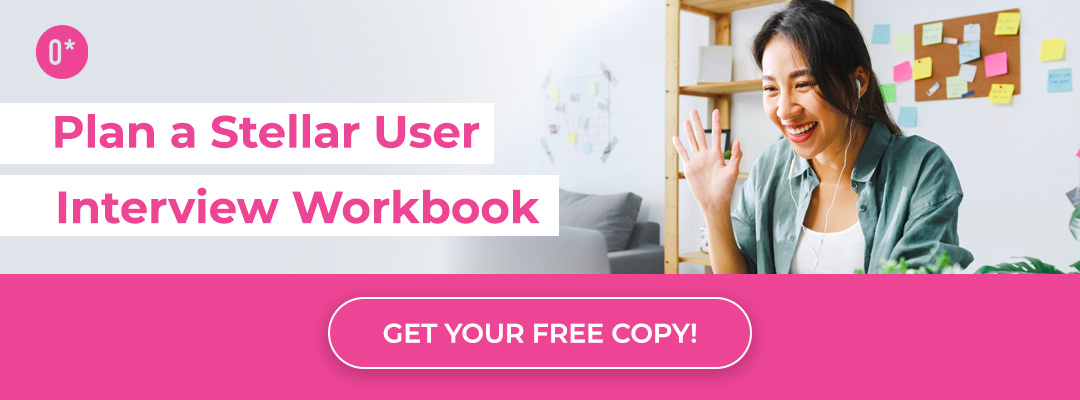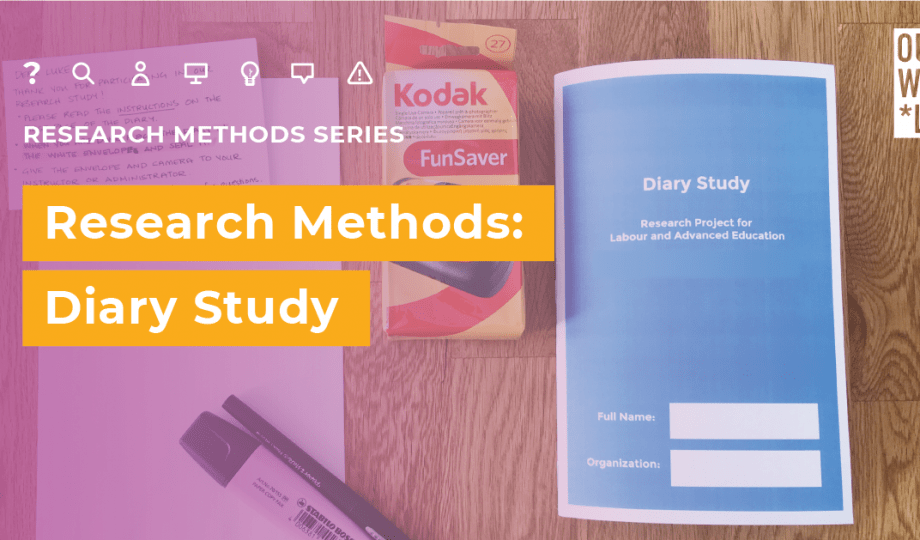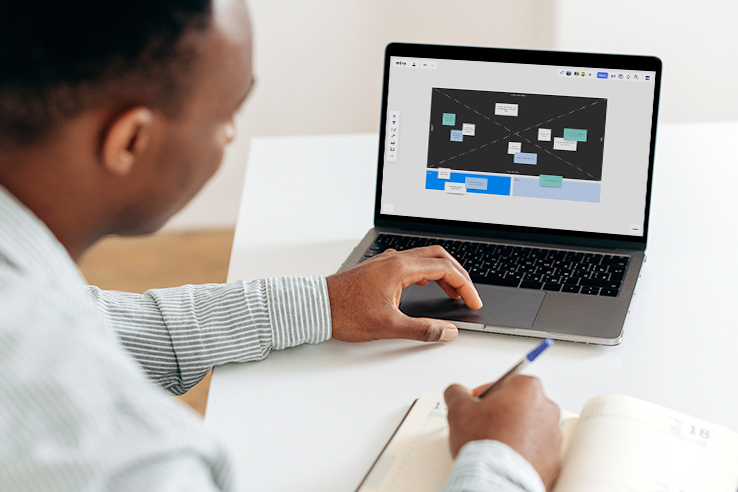In our new three-part blog series, we introduce our favourite qualitative research methods and strategies that you can immediately start applying to your human-centered design projects.
We cover the following design research methods:
-
In-Depth Interviews (in this post)
Do you want to conduct better interviews?
We help you navigate in-depth interviews for your users and customers. We’ll explore how to plan and execute a stellar interview, and we’ll outline our Top 7 Tips for In-Depth Interviewers.
What are in-depth interviews?
In-depth interviews are one of the most common qualitative research methods used in design thinking and human-centered design processes. They allow you to gather a lot of information at once, with relative logistical ease. In-depth interviews are a form of ethnographic research, where researchers observe participants in their real-life environment. They are most effective when conducted in a one-on-one setting.
How and when can you use interviews?
In-depth interviews are best deployed during the Discovery phase of the Human-Centered Design (HCD) process. They are an opportunity to explore and a chance to uncover your user’s needs and challenges. Do you want to find out where they are struggling the most with your service? Now is the time to ask.
Logistics for In-Depth Interviews
Here are our top tips for planning out the logistics for your interviews:
-
Recruiting: Properly recruiting for interviews is a crucial step, and it can sometimes be the most challenging part of the process. Recruitment can either be handled by the client or in-house, and sometimes by an external recruiting firm. You’ll identify the demographics and characteristics of your different user groups as a first step (e.g. by gender, age, occupation, etc.), and then you’ll ideally find 4-6 interview participants that match your recruiting criteria.
-
Scheduling: Outwitly uses a scheduling tool called Calendly to schedule all of our interviews. This handy platform syncs directly with our internal calendars, and it will even hook-up to our web-conferencing tool to send call information directly to the participant.
-
Format: Interviews can be conducted in-person or remotely over the phone, or a combination of the two. An advantage to conducting in-person interviews is that they allow for easier rapport-building, and you’re able to more fully understand the context of how your participant may interact with the product, service, or organization, as well as a holistic picture of their lives. The advantage to remote interviews is that they are easier to schedule and recruit for, and they can really be conducted from anywhere with a cell signal or a WiFi connection. Ideally, you are able to do a mix of both interview types, or you’re able to use remote interviewing in conjunction with another research method, like observations.
-
Duration: The sweet spot for in-depth interview length is between 45–90 minutes. This depends on how many research themes and questions you have, and of course, your participant’s schedule. Anything over 90 minutes can be very draining for both you and the participant.
-
Note-Taking: When possible (and with the participant’s consent), it’s best to audio record interviews. This way you are not scrambling to keep up with your hand-written notes, and you are able to fully engage with the participant and listen closely. At Outwitly, we use manual audio recorders, but the iPhone Voice Record Pro app is also an option for in-person interviews. For remote interviewing, you might opt to use call recording software; we like to use the built-in recording feature of GoToMeeting, which is our preferred web-conference platform. Once audio recordings have been collected, we typically get the recordings transcribed using services like Rev.com. This saves a lot of time during the data analysis phase.
-
Interview Protocol: Before running a set of interviews, it’s important to prepare an ‘interview protocol.’ A protocol is the combination of two things:
1) An introductory script about the research and what the participant can expect from the interview. This is also the time to ask consent for recording and to assure participants that their names and everything they say will be kept confidential.
2) A list of questions that you plan to ask during the interview. You’ll want to divide up your interview questions into sections that reflect your research themes–this way it’s easy for you to skim through the protocol and find your place, and also makes for a smoother interview flow. Preparing a protocol is important because it ensures consistency with your data collection, facilitates data analysis, and allows you to identify patterns.
7 Tips for In-Depth Interviewers
Interviewing is an art form, and it requires a high level of emotional intelligence. You need to be in tune with how comfortable your interviewee/research participant feels, and enable them to open up to you–a complete stranger–about their challenges. Research can sometimes involve particularly sensitive subjects like weight management, divorce, personal finances, and more, so rapport-building (Tip #4) is especially crucial for successful interviewing. Here are our Top 7 best practices for interviewers.
-
Active Listening: The best skill an interviewer can foster is their listening ability. In a strong interview, the interviewer is not interrupting, bringing up their own anecdotes, or asking too many questions. While some of these “what-not-to-do’s” can actually be helpful to make the participant feel comfortable, too many can derail the interview and also lead the participant to certain answers (as discussed in Tip #3). The interview should flow naturally, and you should mostly allow for the participant to lead the conversation. You’ll want to be listening to them, and when appropriate, repeating key points back to them to reiterate that you are actively listening. Asking a question like “I heard you say your biggest challenges are XYZ. Is there anything else?” shows the participants that you are interested in what they are saying, and it encourages them to keep sharing.
-
Probing: ‘Probing’ in the context of in-depth interviews refers to diving deeper on a particular response or topic. Typically, you will have prepared your interview protocol with a list of questions and sub-questions–the latter are your probing questions. For example, you might begin with an open-ended, general question, and as your participant replies, you might ask subsequent questions that encourage them to keep digging into the subject. A good interviewer also knows when to continue probing on a subject–and when to move on.
-
Non-Leading: Learn not to ask leading questions. A leading question is one in which you are making an assumption in the way your question is phrased. This can influence how your participant answers the question. For example, if you ask a participant “What challenges do you have with XYZ?”, you are assuming there are challenges, which may skew the participants response. They may not have any challenges to begin with, but they might reply that there were challenges anyway to fit the question. A better way to ask that question would be: “What challenges, if any, have you had with XYZ?” When prepping the interview protocol, be careful not to draft leading questions. And in the heat of the moment if you go off-script, you’ll need to think about how you’re phrasing your questions.
-
Building Rapport: Learning to build rapport is one of the most important skills to cultivate as an interviewer. By ensuring your participants feel comfortable, they are much more likely to open up to you. Remember to always be friendly and courteous in your communication prior to conducting the interview (e.g. in emails you send regarding scheduling). In the interview, use a tone of voice that is soft and inquisitive, as well as understanding. Introduce yourself as the researcher and explain the research to the participant. Emphasize that you are there to learn about them, and to understand their needs and how the product, service, or organization they are interacting with could be improved to suit them. During the interview, if you hear in their tone of voice that something in their experience was very frustrating, use language to acknowledge that, by saying “It sounds like that was very frustrating” or “I understand” to let them know that you are on their side. Also, reassure them throughout the interview that their feedback is very useful and helpful by saying things like “Thank you – that’s very interesting,” or “I’ve heard that before from others, you are not the only one!”
-
Agility & Go-with-the-Flow Attitude: You can prepare, rehearse, and write your interview protocol, but in every interview you will have to be agile. For example, if you’ve separated your interview questions into sections, and the participant naturally starts talking about a topic that you have written down for a later portion of the interview, you should freely move down to those questions and jump back to where you were afterwards. This way, the interview will feel more organic and conversational, and less robotic. Flexibility is also critical because some participants just do not have a lot to say. In these cases, you’ll be required to think of more “off the cuff” questions, or you’ll need to reconsider whether the interview is still a valuable use of your time and theirs. Knowing when to cut an interview short is also an important skill. For the most part, let the participant lead the conversation, feel comfortable jumping around a little in your protocol, and listen to them to know what other questions you could ask that might not be in the protocol. Also, know when to skip a question if you’ve already gotten a response elsewhere in the interview.
-
Facilitate & Guide: Sometimes interviews will be easy and they’ll naturally follow the flow of your interview protocol. And sometimes they’ll be more challenging, especially if an interviewee is particularly passionate about one topic. In this case, you’ll need to guide your participants as much as possible, so that you can move through more of your questions. This is a delicate balance of listening, finding a time to cut in, and using transitional phrases like “That’s very helpful. I’m mindful of the time, and I would like to ask you some questions about XYZ.”
-
Comfort with Discomfort: It can sometimes be difficult for participants to answer a question quickly in an interview. They might need to think about their answer before responding. Or they may be able to answer quickly, but there might be things in the back of their mind related to the question that might take a minute for them to recall. It’s important to allow interviewees that space to think about the question. From a human perspective, leaving open silence can feel awkward, but it’s important to create space for the participant to remember anything else that might be important. So while you might be sitting there thinking “wow this is awkward,” they are actually just thinking about their answer. On the flip side, you also don’t want to leave too much space in case there is nothing else to add–this can in turn make participants feel insecure that they have not said enough. Perfecting this skill comes with a lot of experience, so for now, try counting to 10, or perhaps mention that you need a few seconds to catch-up on your note taking–this gives them the space to think longer without feeling too much time pressure. Of course, if nothing more comes up, just feel free to move on.
View this post on Instagram
Click through to download your copy now…
Next in our Research Methods blog series, we walk you through best practices for conducting observations and shadowing as part of your research and design process.
Resources we like…
-
Calendly for Scheduling
-
GotoMeeting for Remote Interviewing
-
iPhone Voice Record Pro app for Audio Recording
-
Rev for Audio Transcription




